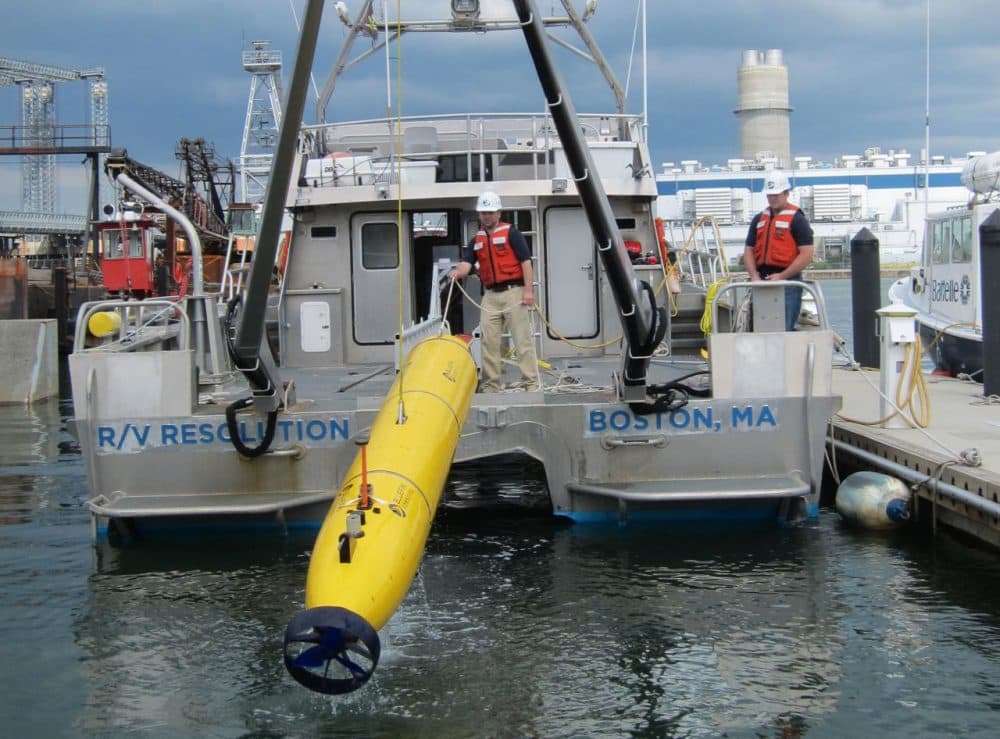Advertisement
Boston-Area Underwater Robot To Aid Search For Malaysia Airlines Flight 370
Resume
Three weeks after the disappearance of Malaysia Airlines Flight 370, the search is now focused in the Indian Ocean. This week the U.S. Navy sent equipment developed by a Boston-area robotics company to help.
Bluefin Robotics is located in an old shipyard by the Quincy waterfront. The facilities look like a cross between a boathouse and a science lab — with thick ropes and bright buoys as well as tiny wires and computer programs buzzing away.
It's here that engineers develop what are called autonomous underwater vehicles, or AUVs. One of them — the Bluefin21 — is now in the southern Indian Ocean, ready for action when the Flight 370 search area is sufficiently narrowed. It will then dive down a little over 2 miles to about 100 feet above the ocean floor and take pictures.
William O'Halloran, who runs Bluefin's marine operations group, shows me a slightly smaller version of the robot, the Bluefin 9.
"What this is used to do is conduct searches and surveys of the sea floor," O'Halloran says.
It looks like a torpedo, or a huge, yellow cigar. The robot searching for Flight 370 is 18 feet long.
Once it's deployed, the Bluefin moves along at the rate a person might jog, following the seabed. So if there's an underwater mountain range, "it flies up the mountain and then back down again," O'Halloran says.
The robot often makes a pattern called "mowing the lawn." It makes one pass over an area, and then comes right back beside it.
The Bluefin captures images as it moves, but instead of using lightwaves, it uses soundwaves. Two side-scan sonars send "pings" out and sense what bounces back. It's like an ultrasound, but this machine patches images together like a big mosaic. O'Halloran explains that the bright yellow covering is invisible to the soundwaves.
"This part here, the plastic part, that's called the shell or the fairing of the vehicle," O'Halloran says. "And because we use a type of plastic that's basically the same to the density of seawater, sound passes through it as if it's not there. So we call it acoustically transparent."
In 24 hours, the robot can image 40 square miles. It would take two days to capture an area the size of the city of Boston. The search area for the Malaysian plane is about 12 times bigger than the state of Massachusetts, so it needs to be narrowed down for the Bluefin to be most effective.
Once the robotic vehicle has "imaged" its patch of the ocean floor, it resurfaces with all the data to find the command ship that's been monitoring it from above.
"So at the end of the mission we recover the vehicle, and that's one of the more challenging processes," O'Halloran says.
He says it's hard to get the robot to line up with the ship.
"The waves [are] moving, the vehicle weighs a lot, the ship weighs a lot. So everything's all moving. You have to make two things move the same," O'Halloran says. "And if you've ever tried to like take dance lessons, you can understand that cannot always be the easiest thing."
Once the robot is back on board, the images are downloaded.
"The resolution of the pictures is less than a photo, so objects look a little fuzzier," says David Kelly, president and CEO of Bluefin Robotics. "It'll be whatever color you want, so you can have it browns or blues, but it's a monochromatic image."
Kelly says the robotic vehicle has a lot of uses: oil and gas infrastructure, mine detection, underwater archaeology. "Bluefin actually got its start doing oceanographic research work down in Antarctica, exploring climate change around the ice edge," Kelly says.
But regardless of where in the world these Bluefin robots are sent, Kelly says they're firmly based in the Boston area.
"Boston is a hub for both the robotics industry and the maritime industry," Kelly says. "A lot of that is driven out of the higher educational institutions, as well as the Woods Hole Oceanographic Institute down on the Cape. It really has this nexus of capability in the state."
The Massachusetts-based development of Bluefin 21 has been two decades in the making. Now the underwater robot is ready for action in the search for Malaysia Airlines Flight 370.
This segment aired on March 29, 2014.